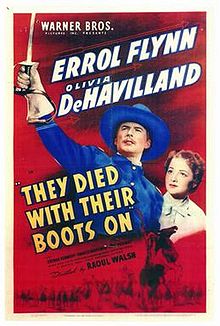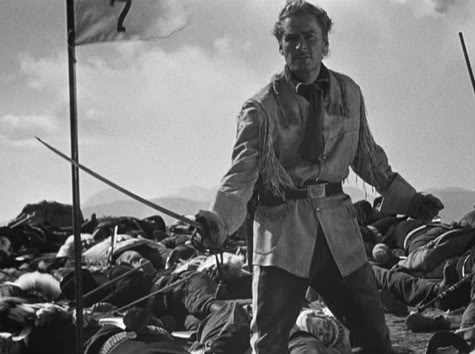

Any resemblance in this movie to actual fact is pretty much accidental. The storyline is complete Hollywood hokum, and it is a good thing that Libbie Custer, George Armstrong’s widow, did not live to see it. She died eight years earlier in 1933. Even she would have shaken her head at some of the liberties taken with the truth, and she was a lady who spent over half a century lecturing throughout the USA defending her husband’s reputation with every fibre of her being.


George Armstrong Custer Libbie Custer
A lot has been written of how Colonel George Armstrong Custer’s vanity, recklessness and pursuit of glory brought about the destruction of the 7th Cavalry at the Battle of the Little Big Horn on 25 June 1876. And most of, just like this movie, is baloney. If we are to believe the self-appointed ‘experts’, Custer blatantly disobeyed orders, negligently split his force into three columns, then foolishly galloped headlong into a trap that wiped out his command. This is the myth that has survived for over a hundred years. Yet it simply did not happen that way.

Brig. General Alfred Terry
First and foremost, he never really received any detailed orders from his superior Brigadier General Alfred Terry. The only instruction he received from Terry was a note on 22 June that read in part:
‘Colonel,
The Brigadier-General commanding directs that as soon as your regiment can be made ready for the march, you will proceed up the Rosebud in pursuit of the Indians whose trail was discovered by Major Reno a few days since. It is, of course, impossible to give you any definite instructions in regard to this movement, and were it not impossible to do so, the Department Commander places too much confidence in your zeal, energy, and ability to wish to impose upon you precise orders which might hamper your action when nearly in contact with the enemy.’

Brig. General George Crook
Clearly, Terry gave Custer carte blanche to act as he saw fit once he came within striking distance of the enemy. Why? Because he trusted his most experienced commander to act with ‘zeal, energy, and ability…’. Unfortunately, totally unexpected and unforeseen circumstances were about to befall the 7th Cavalry and its commander. Far too many writers have mistakenly written that Custer was ordered to find the Indians and then wait until the columns of Terry/Gibbon and George Crook arrived to join him. That was never the plan. Indeed, there was no plan, because nobody expected the Indians to hang about and wait for a battle. Both Terry and Custer expected their enemy’s first objective, as always, would be to remove their women and children from danger by packing up their lodges and fleeing the area. Only once before had they actually attacked a column in numbers, and that was on the 17th at the Rosebud against General Crook, just eight days earlier. That action, one in which an estimated 2,500 Cheyenne and Sioux fought Crook’s 1,300 strong column to a standstill, had instilled a belief in the Indians that overwhelming numbers could defeat cavalry. Crook had been unable to let Terry know of this in time for Custer to be advised that he was in pursuit of a foe who may choose to stand and fight!
Custer intended attacking the Indian village at dawn on the 26th, but his presence was discovered on the morning of the 25th. It was clear to him that if he stuck to his original plan there was every possibility there would be no-one to attack next morning. If the Indians did what they always did when confronted with a large force, they would pack up and escape, probably leaving a smallish band of warriors behind to delay the soldiers and buy time for their families to get to safety. So, for that reason alone, Custer decided to follow the usual cavalry practice when attacking a village. He would split his force into three lines of march and descend upon the encampment from three sides as quickly as possible.
It was then that the famous ‘Custer luck’ ran out. The village he was about to attack just happened to be the greatest concentration of Indians in the history of the west. Estimates vary greatly regarding the numbers present, but most scholars now agree that there were probably around 1,800 – 2,000 lodges containing between 12,500 to perhaps 15,000 Indians, 3,500 – 4,500 of them being warriors. There were Cheyenne, Hunkpapas, Miniconjou, Blackfeet, Santees, Brules, Arapahoe, Sans Arcs and a few others. Custer and the 7th were unlucky enough to encounter the greatest mass of Indians ever seen on the frontier.


Major Marcus Reno Captain Frederick Benteen
Had Major Reno and his command not halted outside the village, but had instead swept on through and joined up with Custer’s column as per his instructions, perhaps their combined force could have kept the hordes at bay? Then, if Captain Benteen had heeded Custer’s message to ‘come quick’, the combined firepower of all three columns may have proved too hot for their adversaries. Of course, all of them may have been killed too, but Custer was entitled to have his instructions obeyed by his subordinates. They let him down. Reno not only halted, he retreated in the face of what survivors initially described as sporadic fire! Benteen took forever to advance, showing no signs of urgency whatsoever. Worst of all, Reno’s withdrawal released hundreds more warriors to deploy against Custer’s beleaguered command.
They Died with Their Boots On (1941) chooses to portray the battle as some kind of crooked deal between politicians and a corporation bent on stealing the Black Hills from the Indians, land that, according to the screenplay, Custer had promised to Chief Crazy Horse! The picture would then have us believe that the seventh deliberately sacrificed their lives to hold up the Sioux and Cheyenne long enough to save all the white settlers in Dakota Territory from being massacred!


Custer, (alias Errol Flynn), saber in hand, Anthony Quinn as Crazy Horse
about to become a legend
Of course, Custer (saber in hand, long hair and all) is killed with the final shot of the battle. And guess who fires it? Chief Crazy Horse! Gimme a break. In reality, by the way, the seventh’s sabers were crated and not taken with them on the campaign. And Custer had his long locks cut short beforehand as well. But wait, there’s more. According to the brainless screenplay, he left behind a dying declaration in which he named all the corporate culprits and absolved the Indians from any responsibility. Oh, and one last thing. The tune Garry Owen, the 7th Cavalry’s signature piece, did not originate in Australia, regardless of who says so in this picture. It is an Irish quick-step dating back to the 1860s.

Jim Thorpe
Only 16 Sioux were used in the film. They appeared in all the close-ups (except for Mexican-born Anthony Quinn). Most of the remainder of the hundreds of extras were Filipinos. Former All-American and Olympic star Jim Thorpe was an extra in this and other westerns. According to some sources he had an altercation with the star of the picture Errol Flynn. They came to blows and Thorpe (apparently) knocked him out.

Louis Zamperini 1941
Another extra is believed to have been Louis Zamperini, the subject of the 2014 film Unbroken. A bombardier in a B-24 in the Pacific, Zamperini was aboard the aircraft when it struck mechanical problems and crash-landed in the ocean in May 1943. He and two other crew members spent 43 days adrift in a rubber life-raft before being captured by the Japanese and imprisoned for two years. Zamperini survived both ordeals and lived to the ripe old age of 97 before dying in 2014.

Leave a Reply